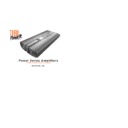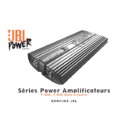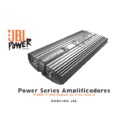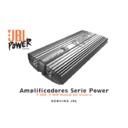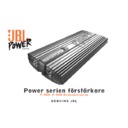JBL P 4040 (serv.man8) User Manual / Operation Manual ▷ View online
3
• Always wear protective eyewear when
using tools.
• When routing cables, keep input signal
cables away from power cables and
speaker wires.
speaker wires.
• When making connections, make sure
that each connection is clean, insulated
and properly secured. Observe the
polarity markings on the rear panel.
Refer to the application drawings to set
up the amplifier for operation in stereo,
bridged-mono, bi-amp or tri-mode con-
figurations.
and properly secured. Observe the
polarity markings on the rear panel.
Refer to the application drawings to set
up the amplifier for operation in stereo,
bridged-mono, bi-amp or tri-mode con-
figurations.
• If the amplifier’s fuse must be replaced,
use only the same rating and type as a
replacement. Do not substitute another
kind.
replacement. Do not substitute another
kind.
Controls and Connectors
1. Pre-amp Level Input Connector –
Connects to line-level output from the
source unit.
source unit.
2. Universal Interface Speaker-Level
Connector – Connects to speaker-level
output from the source unit. Provides
Common Sense amplifier turn-on
when used with factory radios
(2-channel on P-4020, 4-channel on
P-4040).
output from the source unit. Provides
Common Sense amplifier turn-on
when used with factory radios
(2-channel on P-4020, 4-channel on
P-4040).
3. Pre-amp Level Output Connector –
Connects to other amps or processors
in the signal chain (flat on P-4020, flat
or filtered on P-4040).
in the signal chain (flat on P-4020, flat
or filtered on P-4040).
4. Speaker-Output Connector – (2-chan-
nel on P-4020, 4-channel on P-4040).
5. Fuses – P-4020: 20A ATC type, P-4040:
30A ATC type.
6. Power Connector – Connection for
12V +, Gnd and Rem.
7. Input-Mode Switch – Sums left and
right inputs.
8. Input-Sensitivity Control – Adjusts
input sensitivity for pre-amp level and
speaker-level inputs.
speaker-level inputs.
9. Pre-amp Output Selector Switch –
Selects input path for pre-amp output.
Output can be summed from front and
rear inputs with no filter, or filtered by
the front or rear crossover.
Output can be summed from front and
rear inputs with no filter, or filtered by
the front or rear crossover.
10. Rear-Channel Input Selector – Selects
rear-channel input between front input
and rear input.
and rear input.
11. Crossover Selector – Determines
whether the crossover is a High-Pass
filter (HP), a Low-Pass filter (LP) or
unfiltered (Flat).
filter (HP), a Low-Pass filter (LP) or
unfiltered (Flat).
LEVEL
INPUT MODE
MO ST
4V
.250V
XOVER
FLAT
HP
LP
2V
20
–
R
+
–
L
+
+BATT
REM
GND
BRIDGE
SPEAKER OUTPUTS
POWER
FUSE
20A
MADE IN THE U.S.A.
R
L
LINE LEVEL
INPUT
SPEAKER LEVEL IN
R
+
–
L
+
–
AUX
OUT
R
L
+ R –
+ R –
– L +
– L +
AUX
OUT
OUT
R
L
R
L
FRONT
FRONT
REAR
LINE LEVEL
INPUT
SPKR LEVEL IN
REAR
ST MO
INPUT MODE
PRE OUT
LEVEL
INPUT MODE
MO ST
4V
.250V
FRONT
F+R
FLAT
REAR
LP
FRT
LP
LP
FRT
REAR
XOVER
FLAT HP LP
XOVER
FLAT
HP
LP
LEVEL
4V
.250V
2V
2V
REAR
INPUT
F U S E
3 0 A
B R I D G E
– R +
– L +
MADE IN THE U.S.A.
+BATT
REM
GND
BRIDGE
SPEAKER OUTPUTS
POWER
FRONT
REAR
30
8
7
11
5
4
6
1
2
3
1
2
3
9
10
8
7
11
8
11
4
5
6
P-4020
P-4040
7
P-4020/4040 OM. 7/14/98 11:42 AM Page 3
4
Mounting the Amplifier
The JBL P-4020 (or P-4040) can be
mounted in virtually any location inside
the vehicle. However, make sure to keep
the amplifier away from heater vents or
ducts.
1. At the chosen site, use the amplifier as
mounted in virtually any location inside
the vehicle. However, make sure to keep
the amplifier away from heater vents or
ducts.
1. At the chosen site, use the amplifier as
a mounting template and mark the
locations of the four mounting holes.
locations of the four mounting holes.
2. Drill a small pilot hole at each marked
location.
3. Mount the amplifier and securely
tighten the mounting screws.
Wiring the Power Connections
Refer to diagrams on page 3 for connec-
tor locations.
1. For power, remote and speaker wires,
tor locations.
1. For power, remote and speaker wires,
strip 1⁄4" off one end of each jacket to
reveal bare wire for insertion into the
barrier strip connectors.
reveal bare wire for insertion into the
barrier strip connectors.
2. Locate the 3-connection barrier strip
labeled +Batt, Rem and Gnd. Connect a
black wire (at least 12G) to the Gnd ter-
minal and connect the other end to the
nearest bare-metal chassis component.
Then, connect a red wire (at least 12G)
from the vehicle’s +12-volt battery ter-
minal to the +Batt terminal on the bar-
rier strip. Finally, connect a blue wire
(16G) to the Rem terminal on the bar-
rier strip and connect the other end to
the Rem output of the source unit. (If
you are using speaker-level inputs and
speaker-level outputs from the source,
disregard the previous instruction
regarding the Rem terminal.)
black wire (at least 12G) to the Gnd ter-
minal and connect the other end to the
nearest bare-metal chassis component.
Then, connect a red wire (at least 12G)
from the vehicle’s +12-volt battery ter-
minal to the +Batt terminal on the bar-
rier strip. Finally, connect a blue wire
(16G) to the Rem terminal on the bar-
rier strip and connect the other end to
the Rem output of the source unit. (If
you are using speaker-level inputs and
speaker-level outputs from the source,
disregard the previous instruction
regarding the Rem terminal.)
Wiring the Speaker Output
Connections
Connections
1. Connect the speakers, observing
proper polarity, to the speaker output
barrier strip on the amplifier using at
least 16G high-quality speaker wire.
(Note: The total impedance of the
speakers connected to the outputs,
when the amp is driven in stereo,
must be at least 2 ohms.)
barrier strip on the amplifier using at
least 16G high-quality speaker wire.
(Note: The total impedance of the
speakers connected to the outputs,
when the amp is driven in stereo,
must be at least 2 ohms.)
2. If you are bridging the amplifier, con-
nect the speaker wires to the terminals
marked “bridge,” observing proper
polarity. (Note: The total impedance of
the speaker system to be connected to
the amplifier must be at least 4 ohms
in bridge mode.)
marked “bridge,” observing proper
polarity. (Note: The total impedance of
the speaker system to be connected to
the amplifier must be at least 4 ohms
in bridge mode.)
3. If you are running the amp in tri-mode
(stereo and mono simultaneously to
one or two pairs of satellite speakers
and a subwoofer), refer to the chart
above to determine the capacitor and
inductor values you’ll need to route
bass signals to the woofer, and
midrange and high frequencies to the
satellite speakers. These passive
crossover components will also ensure
that the impedance of the speaker sys-
tem doesn’t drop below 2 ohms.
one or two pairs of satellite speakers
and a subwoofer), refer to the chart
above to determine the capacitor and
inductor values you’ll need to route
bass signals to the woofer, and
midrange and high frequencies to the
satellite speakers. These passive
crossover components will also ensure
that the impedance of the speaker sys-
tem doesn’t drop below 2 ohms.
(Fig. 7)
Wiring the Input Connections
1. If you are using conventional RCA
input connections and a source unit
with output voltage less than 4V, sim-
ply plug the RCA plugs into the RCA
jacks on the amplifier.
with output voltage less than 4V, sim-
ply plug the RCA plugs into the RCA
jacks on the amplifier.
2. If you are connecting the amplifier to
a factory-installed source unit, or to a
source unit that only has speaker-level
outputs, connect the speaker outputs
of the source to the speaker inputs on
the amp, observing the following color
codes:
Front Left+: White
Front Left–: White with black stripe
Front Right+: Gray
Front Right–: Gray with black stripe
Rear Left+: Green
Rear Left–: Green with black stripe
Rear Right+: Purple
Rear Right–: Purple with black stripe
(Note: When using the Universal
Interface speaker-level inputs and line-
level outputs, the Rem terminal on the
amplifier may be used as a remote out-
put connection, and will provide power
to turn on other amplifiers and proces-
sors in the system.)
source unit that only has speaker-level
outputs, connect the speaker outputs
of the source to the speaker inputs on
the amp, observing the following color
codes:
Front Left+: White
Front Left–: White with black stripe
Front Right+: Gray
Front Right–: Gray with black stripe
Rear Left+: Green
Rear Left–: Green with black stripe
Rear Right+: Purple
Rear Right–: Purple with black stripe
(Note: When using the Universal
Interface speaker-level inputs and line-
level outputs, the Rem terminal on the
amplifier may be used as a remote out-
put connection, and will provide power
to turn on other amplifiers and proces-
sors in the system.)
3. If you are connecting your Power
Series amplifier to a source unit with
output voltage higher than 4V, connect
the output-signal wires of the source
unit to the Universal Interface speaker
inputs. Because the inputs have an
impedance of 10K ohms, this connec-
tion will provide the best noise-free
performance possible.
output voltage higher than 4V, connect
the output-signal wires of the source
unit to the Universal Interface speaker
inputs. Because the inputs have an
impedance of 10K ohms, this connec-
tion will provide the best noise-free
performance possible.
FREQUENCY
INDUCTOR
CAPACITOR
Crossover
6dB/oct. LP
6dB/oct. HP
(4 ohm)
(4 ohm)
75Hz
8.0mH
530µF
100Hz
6.4mH
400µF
125Hz
5.0mH
318µF
150Hz
4.2mH
265µF
175Hz
3.6mH
227µF
200Hz
3.2mH
198µF
P-4020/4040 OM. 7/14/98 11:42 AM Page 4
5
4. In some systems it may be desirable
to have two sources play simultane-
ously through the audio system. For
instance, if you have a factory-installed
radio in your car and you want to add
an aftermarket CD player, you may
connect the CD player to the RCA
inputs of the amp and the factory radio
to the Universal Interface speaker
inputs. (Note: Front and rear channels
of the CD and radio must be driven
into the front and rear inputs of the
amplifier. Use Y adapters if necessary.)
The Universal Interface circuitry will
isolate the two signals from each other
while allowing them to drive the amp
simultaneously. Therefore, switching
from one source to the other is as sim-
ple as turning the unused source off,
and the other on. (Note: you must con-
nect the remote turn-on wire from the
CD player to the Rem terminal on the
amp. Install a diode in the remote line
from the CD player as shown in the
diagram above.)
ously through the audio system. For
instance, if you have a factory-installed
radio in your car and you want to add
an aftermarket CD player, you may
connect the CD player to the RCA
inputs of the amp and the factory radio
to the Universal Interface speaker
inputs. (Note: Front and rear channels
of the CD and radio must be driven
into the front and rear inputs of the
amplifier. Use Y adapters if necessary.)
The Universal Interface circuitry will
isolate the two signals from each other
while allowing them to drive the amp
simultaneously. Therefore, switching
from one source to the other is as sim-
ple as turning the unused source off,
and the other on. (Note: you must con-
nect the remote turn-on wire from the
CD player to the Rem terminal on the
amp. Install a diode in the remote line
from the CD player as shown in the
diagram above.)
System Setup and Adjustment
Electronic Crossover
The electronic crossover in the P-4020 and
P-4040 should be used to route the appro-
priate signal to speakers intended to play
only bass, or only midrange and treble fre-
quencies. The crossover slope is 12dB/oct
and the frequency is fixed at 80Hz.
Pre-amp Outputs
Connect these to the input connectors of
other amplifiers or processors in your
system. Refer to the “Applications” sec-
tion for system expansion possibilities.
Setting Input Sensitivity
Proper input-sensitivity control settings
on Power Series amplifiers are critical to
ensure optimum performance, low noise
levels and maximum system reliability.
As a general rule, controls at the front
end of a system (source, equalizers and
other processors) should be set as high
as possible with the amplifier input sensi-
tivity set as low as possible while still
providing adequate volume levels. Using
a high signal level and a low-sensitivity
setting will help keep background noise
in the system to a minimum.
The electronic crossover in the P-4020 and
P-4040 should be used to route the appro-
priate signal to speakers intended to play
only bass, or only midrange and treble fre-
quencies. The crossover slope is 12dB/oct
and the frequency is fixed at 80Hz.
Pre-amp Outputs
Connect these to the input connectors of
other amplifiers or processors in your
system. Refer to the “Applications” sec-
tion for system expansion possibilities.
Setting Input Sensitivity
Proper input-sensitivity control settings
on Power Series amplifiers are critical to
ensure optimum performance, low noise
levels and maximum system reliability.
As a general rule, controls at the front
end of a system (source, equalizers and
other processors) should be set as high
as possible with the amplifier input sensi-
tivity set as low as possible while still
providing adequate volume levels. Using
a high signal level and a low-sensitivity
setting will help keep background noise
in the system to a minimum.
Initially, turn the input sensitivity GAIN
control to its minimum (counterclock-
wise) position.
control to its minimum (counterclock-
wise) position.
1. Reconnect the (–) negative lead to your
vehicle’s battery. Apply power to the
audio system and play a favorite music
track from CD or tape. (Note: After the
source unit is on, the JBL badge (on the
top panel) will illuminate, indicating the
amplifier is on. If not, check the wiring,
especially the remote connection from
the source unit. Also refer to “Trouble-
shooting” on page 7.)
audio system and play a favorite music
track from CD or tape. (Note: After the
source unit is on, the JBL badge (on the
top panel) will illuminate, indicating the
amplifier is on. If not, check the wiring,
especially the remote connection from
the source unit. Also refer to “Trouble-
shooting” on page 7.)
2. On the source unit, increase the volume
control until it is approximately 3/4 of
its maximum output level. Slowly
increase the Input Sensitivity control
(clockwise) toward three o’clock and,
at the same time, listen to the quality
of the reproduced sound. At some
point, you’ll hear distortion on the
music peaks. Stop the adjustment and
turn it back slightly. This is the maxi-
mum undistorted output level of your
system, and it should not be exceeded
during use.
its maximum output level. Slowly
increase the Input Sensitivity control
(clockwise) toward three o’clock and,
at the same time, listen to the quality
of the reproduced sound. At some
point, you’ll hear distortion on the
music peaks. Stop the adjustment and
turn it back slightly. This is the maxi-
mum undistorted output level of your
system, and it should not be exceeded
during use.
3. After adjusting the level of the main
speakers in your system, you should
adjust the remaining channels (if you
are using a P-4040 or a multi-amp
system) for the desired system bal-
ance. You’ll find this easiest to do by
adjusting the channels in the following
order: 1) front speakers, 2) rear speak-
ers, 3) subwoofer. Elaborate, multi-
channel systems may be complex to
adjust. Your local JBL installation spe-
cialist is the best person to help with
such an adjustment.
adjust the remaining channels (if you
are using a P-4040 or a multi-amp
system) for the desired system bal-
ance. You’ll find this easiest to do by
adjusting the channels in the following
order: 1) front speakers, 2) rear speak-
ers, 3) subwoofer. Elaborate, multi-
channel systems may be complex to
adjust. Your local JBL installation spe-
cialist is the best person to help with
such an adjustment.
Applications
For your convenience, we’ve included
several application diagrams to help you
plan your own system installation.
Figures 1 through 3 show how to config-
ure the JBL P-4020 or P-4040 for stereo,
bridged-mono and tri-mode operation.
For system expansion ideas, see Figures
4 and 5 on the next page. (Note: For sim-
plicity, Figures 1 through 5 do not show
power, remote and input connections.)
several application diagrams to help you
plan your own system installation.
Figures 1 through 3 show how to config-
ure the JBL P-4020 or P-4040 for stereo,
bridged-mono and tri-mode operation.
For system expansion ideas, see Figures
4 and 5 on the next page. (Note: For sim-
plicity, Figures 1 through 5 do not show
power, remote and input connections.)
Many different system configurations are
possible using the crossovers and pre-
amp outputs featured in Power Series
amplifiers. If you are considering expand-
ing your system beyond what is shown
here, please consult your local JBL instal-
lation specialist, who is experienced in
designing complex mobile-audio systems.
possible using the crossovers and pre-
amp outputs featured in Power Series
amplifiers. If you are considering expand-
ing your system beyond what is shown
here, please consult your local JBL instal-
lation specialist, who is experienced in
designing complex mobile-audio systems.
From
Source
Unit
Source
Unit
To
Amp
Amp
IN4001 Diode
P-4020/4040 OM. 7/14/98 11:42 AM Page 5
F U S E
3 0 A
B R I D G E
– R +
– L +
MADE IN THE U.S.A.
+BATT
REM
GND
BRIDGE
SPEAKER OUTPUTS
POWER
FRONT
REAR
30
6
20
–
R
+
–
L
+
+BATT
REM
GND
BRIDGE
SPEAKER OUTPUTS
POWER
FUSE
20A
MADE IN THE U.S.A.
F U S E
3 0 A
B R I D G E
– R +
– L +
MADE IN THE U.S.A.
+BATT
REM
GND
BRIDGE
SPEAKER OUTPUTS
POWER
FRONT
REAR
30
20
–
R
+
–
L
+
+BATT
REM
GND
BRIDGE
SPEAKER OUTPUTS
POWER
FUSE
20A
MADE IN THE U.S.A.
LEVEL
INPUT MODE
MO ST
4V
.250V
XOVER
FLAT
HP
LP
2V
20
–
R
+
–
L
+
+BATT
REM
GND
BRIDGE
SPEAKER OUTPUTS
POWER
FUSE
20A
MADE IN THE U.S.A.
LEVEL
INPUT MODE
MO ST
4V
.250V
XOVER
FLAT
HP
LP
2V
Figure 1. This wiring diagram shows
a JBL P-4020 amplifier set to stereo
to drive a pair of full-range speakers.
a JBL P-4020 amplifier set to stereo
to drive a pair of full-range speakers.
Figure 2. This wiring dia-
gram shows a JBL P-4020
amplifier set to bridge
mode (mono) to drive a
single subwoofer.
gram shows a JBL P-4020
amplifier set to bridge
mode (mono) to drive a
single subwoofer.
Figure 3. This wiring diagram
shows a JBL P-4020 amplifier set
for tri-mode operation. For a
desired crossover frequency, use
the chart on page 4 to select an
inductor for the subwoofer, and
corresponding capacitors for left
and right speakers.
shows a JBL P-4020 amplifier set
for tri-mode operation. For a
desired crossover frequency, use
the chart on page 4 to select an
inductor for the subwoofer, and
corresponding capacitors for left
and right speakers.
Figure 4. In this example system,
the front channels of a P-4040
drive a pair of 5-1/4" 2-way speak-
ers, and the rear channels are
bridged to drive a single 12"
woofer.
the front channels of a P-4040
drive a pair of 5-1/4" 2-way speak-
ers, and the rear channels are
bridged to drive a single 12"
woofer.
ST MO
INPUT MODE
PRE OUT
LEVEL
INPUT MODE
MO ST
4V
.250V
FRONT
F+R
FLAT
REAR
LP
FRT
LP
LP
FRT
REAR
XOVER
FLAT HP LP
XOVER
FLAT
HP
LP
LEVEL
4V
.250V
2V
2V
REAR
INPUT
+ R –
+ R –
– L +
– L +
AUX
OUT
OUT
R
L
R
L
FRONT
FRONT
REAR
LINE LEVEL
INPUT
SPKR LEVEL IN
REAR
R
L
LINE LEVEL
INPUT
SPEAKER LEVEL IN
R
+
–
L
+
–
AUX
OUT
R
L
Figure 5. In this expanded system, a JBL P-4040 drives two pairs of 6-1/2" 2-way speakers.
The JBL P-4040’s pre-amp outputs feed a JBL P-4020 to drive a single 12" subwoofer in
bridge mode.
The JBL P-4040’s pre-amp outputs feed a JBL P-4020 to drive a single 12" subwoofer in
bridge mode.
ST MO
INPUT MODE
INPUT
PRE OUT
LEVEL
INPUT MODE
MO ST
4V
.250V
FRONT
F+R
FLAT
REAR
LP
FRT
LP
LP
FRT
REAR
REAR
XOVER
FLAT HP LP
XOVER
FLAT
HP
LP
LEVEL
4V
.250V
2V
2V
20
–
R
+
–
L
+
+BATT
REM
GND
BRIDGE
SPEAKER OUTPUTS
POWER
FUSE
20A
MADE IN THE U.S.A.
LEVEL
INPUT MODE
MO ST
4V
.250V
XOVER
FLAT
HP
LP
2V
LEVEL
INPUT MODE
MO ST
4V
.250V
XOVER
FLAT
HP
LP
2V
P-4020/4040 OM. 7/14/98 11:42 AM Page 6
Display

